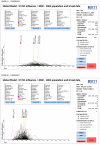Controlling pandemic flu: the value of international air travel restrictions
- PMID: 17476323
- PMCID: PMC1855004
- DOI: 10.1371/journal.pone.0000401
Controlling pandemic flu: the value of international air travel restrictions
Abstract
Background: Planning for a possible influenza pandemic is an extremely high priority, as social and economic effects of an unmitigated pandemic would be devastating. Mathematical models can be used to explore different scenarios and provide insight into potential costs, benefits, and effectiveness of prevention and control strategies under consideration.
Methods and findings: A stochastic, equation-based epidemic model is used to study global transmission of pandemic flu, including the effects of travel restrictions and vaccination. Economic costs of intervention are also considered. The distribution of First Passage Times (FPT) to the United States and the numbers of infected persons in metropolitan areas worldwide are studied assuming various times and locations of the initial outbreak. International air travel restrictions alone provide a small delay in FPT to the U.S. When other containment measures are applied at the source in conjunction with travel restrictions, delays could be much longer. If in addition, control measures are instituted worldwide, there is a significant reduction in cases worldwide and specifically in the U.S. However, if travel restrictions are not combined with other measures, local epidemic severity may increase, because restriction-induced delays can push local outbreaks into high epidemic season. The per annum cost to the U.S. economy of international and major domestic air passenger travel restrictions is minimal: on the order of 0.8% of Gross National Product.
Conclusions: International air travel restrictions may provide a small but important delay in the spread of a pandemic, especially if other disease control measures are implemented during the afforded time. However, if other measures are not instituted, delays may worsen regional epidemics by pushing the outbreak into high epidemic season. This important interaction between policy and seasonality is only evident with a global-scale model. Since the benefit of travel restrictions can be substantial while their costs are minimal, dismissal of travel restrictions as an aid in dealing with a global pandemic seems premature.
Conflict of interest statement
Figures





References
-
- Rvachev LA, Longini IM., Jr A mathematical model for the global spread of influenza. Math Biosci. 1985;75:3–22.
-
- Grais RF, Ellis JH, Glass GE. Assessing the impact of airline travel on the geographic spread of pandemic influenza. Eur J Epidemiol. 2003;18:1065–1072. - PubMed
-
- Grais RF, Ellis JH, Kress A, Glass GE. Modeling the spread of annual influenza epidemics in the U.S.: The potential role of air travel. Health Care Manag Sci. 2004;7:127–134. - PubMed
Publication types
MeSH terms
Grants and funding
LinkOut - more resources
Full Text Sources
Medical

